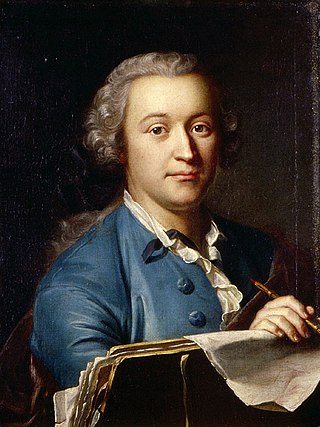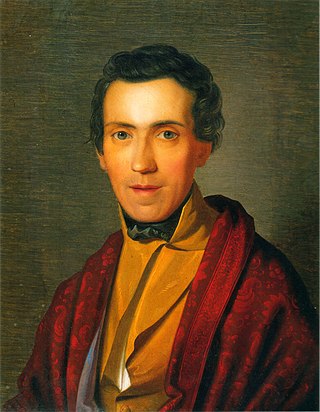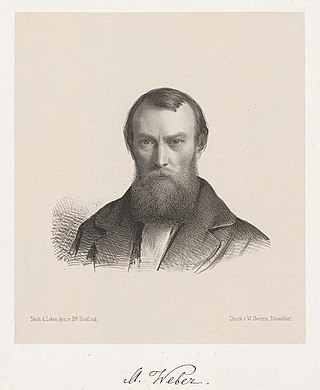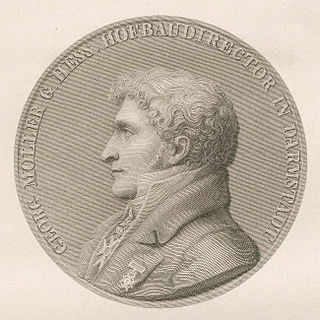Life and work
He studied in Darmstadt with the landscape painter, Johann Georg Primavesi. In 1818, he took an extended study trip throughout Switzerland. His drawings and engravings from that trip were published in Bern by Johann Peter Lamy [ de ], under the title Souvenirs Suisse.
A scholarship from the Grand Duchy of Hesse enabled him to study in Italy. In 1823, he and his friend, the painter Ernst Fries, went to Rome, where he made the acquaintance of Ludwig Richter. He and Richter hiked together through the Monti Sabini and reached Naples in 1825. Shortly after, he climbed Vesuvius, with a team consisting of Richter, Carl Götzloff, Friedrich Ludwig von Maydell [ de ], and several other artists.
Back in Rome, he became a sought-after painter of landscapes and vedute. During his five years in Italy, he developed a free style that focused on nature. He returned to Germany with over 400 sheets of sketches, drawings and watercolors, many of which he later rendered in oil.
in 1828, he became a court painter, primarily for the theatre. He also took students, including August Weber and August Becker. Two years later, he married Philippine Catharina Cramer; daughter of the businessman, Johann Christoph Cramer. They had eight children. In 1833, he was one of the co-founders of the Kunstverein Darmstadt [ de ] (artists' association). He also continued to travel, notably through the Black Forest to Switzerland with Johann Wilhelm Schirmer. In 1843, he went to the Bavarian Alps and the Salzkammergut by way of Munich. On his travels he created numerous studies in oil with daily notes.

Johann Ludwig Aberli was a Swiss painter and etcher.

Adrian Ludwig Richter was a German painter and etcher, who was strongly influenced by Erhard and Chodowiecki. He was a representative of both Romanticism and Biedermeier styles.

Johann Michael Ferdinand Heinrich Hofmann was a German painter of the late 19th to early 20th century. He was the uncle of the German painter Ludwig von Hofmann. He was born in Darmstadt and died in Dresden. He is best known for his many paintings depicting the life of Jesus Christ.

Elias Gottlob Haussmann was a German painter in the late Baroque era. Haussmann served as court painter at Dresden, and from 1720, as the official portraitist at Leipzig. He is mostly known for his portrait of Johann Sebastian Bach which was painted in 1746.

Otto Magnus Freiherr von Stackelberg was a Baltic German, Imperial Russian archaeologist, as well as a writer, painter and art historian.

Johann Baptist Wilhelm August Weber was a German painter; associated with the Düsseldorfer Malerschule.

The Weimar Princely Free Drawing School was an art and literature educational establishment. It was set up in 1776 in Weimar by the scholar and ducal private-secretary Friedrich Justin Bertuch (1747–1822) and the painter Georg Melchior Kraus (1737–1806), as part of Weimar Classicism. It was financed by the young Charles Augustus, Grand Duke of Saxe-Weimar-Eisenach and heavily promoted by Goethe, who also taught there. Among its pupils were Charles Augustus's future mistress Karoline Jagemann. It lasted until 1930.

Heinrich Altherr was a Swiss painter. He is best known for his murals in churches and various public buildings.

Johann Ludwig Bleuler, sometimes called Louis was a Swiss painter, landscape artist and publisher.

Ludwig Hess was a Swiss landscape painter and engraver.

Georg Moller was an architect and a town planner who worked in the South of Germany, mostly in the region today known as Hessen.

Johann Heinrich Schönfeld (1609–1684) was a German painter in the Baroque style.

August Becker was a German landscape painter; associated with the Düsseldorfer Malerschule.

Ferdinand Kobell was a German painter and copper engraver.

Karl Philipp Fohr, a brother of Daniel Fohr, was a German painter, born at Heidelberg in 1795.

Franz Theobald Horny was a German painter in the Romantic style.

The Temple of Juno in Agrigento is an 1828-1830 oil on canvas painting of by Caspar David Friedrich. It is now in the Museum für Kunst und Kulturgeschichte, in Dortmund, which bought it from a Cologne art dealer in 1951. It is said to have been previously owned by the F. A. Brockhaus publishers in Leipzig.
Friedrich Ludwig Heinrich Waagen also Christian Friedrich Ludwig Heinrich Waagen, Wagen or Wage) was a German portrait, history and landscape painter born in the Holy Roman Empire. Hardly anything is known about his works. However, he had acquired extensive knowledge of art, amassed a collection of paintings in Hamburg and was known to friends with or in-laws of many important personalities of his time. Gustav Friedrich Waagen (1794-1868) and Carl Waagen (1800-1873) are his sons.

Johann Heinrich Höfer was a German landscape and portrait painter.

Johann Konrad Zeller was a Swiss painter. He worked in several genres, including landscapes, portraits, and historical scenes. In addition to his paintings, he produced a large number of anatomical drawings, many of which were done in watercolors.
This page is based on this
Wikipedia article Text is available under the
CC BY-SA 4.0 license; additional terms may apply.
Images, videos and audio are available under their respective licenses.




















